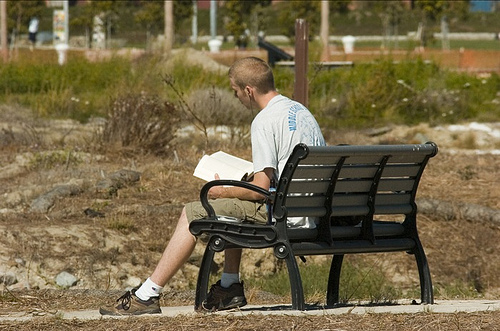
It's a common refrain these days. I catch myself saying it. My friends say it. I overhear it at the book store. "I just haven't had time to read." The truth is that we all have enough time to do anything we want - but it comes at a price. The opportunity cost of reading a book for half an hour is not checking emails for half an hour, or not talking to friends on Twitter for half an hour, or not improving your Candy Crush scores for half an hour, or, or, or…
There is a whole world of entertaining distractions before us, and it can be difficult to pull back and reach for a book instead. Books just lie there quietly, waiting for you to pick them up. Unlike everything else that's distracting us in our modern lives, books don't flash or ding or do a little dance to get your attention. Maybe we would all read more if, every few hours in the evening, our books would play a little chime. (The first person to make this app for the Kindle will be a genius.)
I'm as guilty of this as anyone. (Maybe more so than some.) To make things worse, I can't read before bed as many people do. I only read books that engage my attention 100 percent, and if a book is that engaging and I try to read it before bed, the next thing I know it's 2 a.m. and I'm wide awake still reading.
1. Set a timer
I derived this technique from the famous Pomodoro productivity method. I set a timer for 10, 15, 30 minutes - however long I can budget for reading - then I sit down and start reading. This is the method that has been most successful for me lately. Because I can rely on the timer to let me know when my time is up, I don't get distracted by thoughts of "I should be doing…" because I know I will do them when I'm done.
This can also be a good technique for family situations. Let your family know that when you are reading you are NOT to be disturbed - but that you will be available as soon as the timer goes off. You may only be able to carve out five minutes a day for yourself this way, but it's better than nothing!

Image courtesy Flickr/Studio H. (Chris)
2. Lunch breaks
Depending on your worksite situation, you may be able to get a lot of reading done at lunch. This may require you to get creative with your reading locations.
Most offices and work sites do not afford much privacy by design. Look for waiting areas, unoccupied loading docks, empty conference rooms, remote and rarely-used break rooms and the like. I have had a few jobs where I drove to work and parked nearby, which was awesome: Your car is like a personal rolling library.
I have also had coworkers who read in the common lunch room, by virtue of refusing to talk to anyone. They made it known that, even though they were sitting with everyone else, they dedicated lunch time to reading, and were not to be disturbed. An effective technique, if somewhat off-putting.

Image courtesy Flickr/Debbi Long
3. Dedicate a reading night
I find that the more time I spend reading in a single session, the more into it I get. I can get more reading done in a single three-hour chunk than in six half-hour chunks. I don't know why this is, but I'm sure I'm not alone.
I love dedicating a Reading Night. I get take-out for dinner so that I don't have to waste time cooking, set my phone to silent, and settle in. Blocking off a quiet night for reading may not be realistic for everyone. If you have a family, perhaps you can rope them all into having a Family Reading Night, or trade duties with your spouse to finagle some reading time for yourself.

Image courtesy Flickr/paulbence
4. Audiobooks
Audiobooks are a great weapon in the war against time sinks. You can listen to books while exercising, on your daily commute, or running errands. Your local library no doubt has tons of free audiobooks (both on CD and digital), or you can sign up for Audible.com which has pretty much all of them. Audiobooks are so great, they feel like cheating!
Main image courtesy Flickr/moriza

1 comments